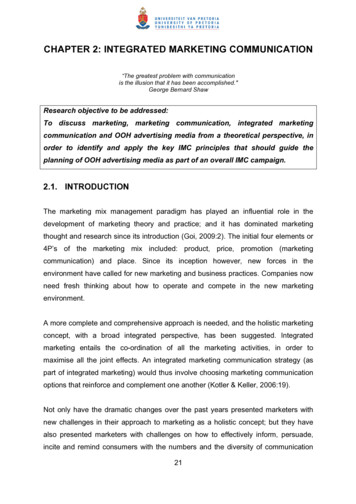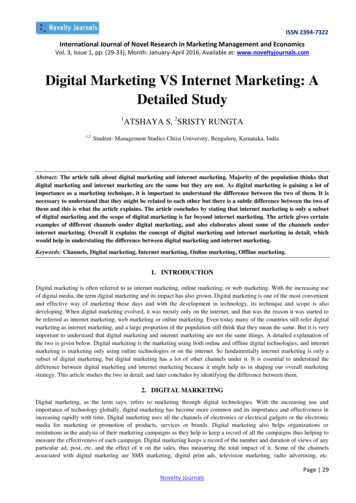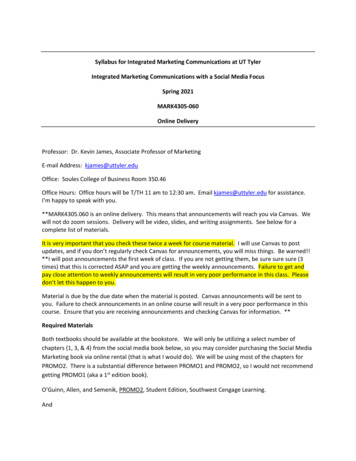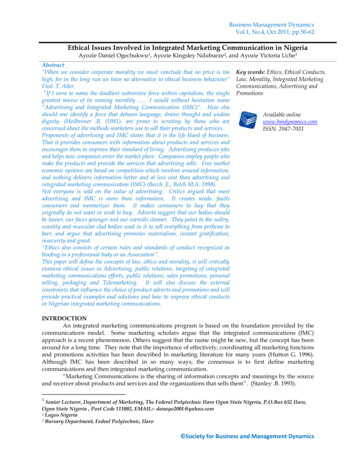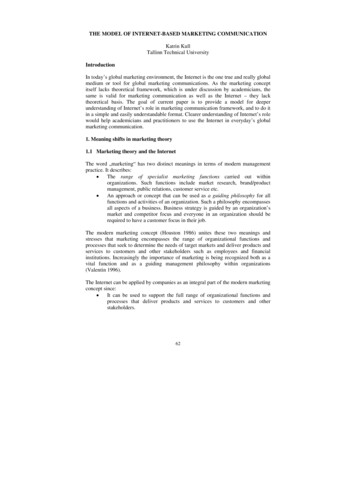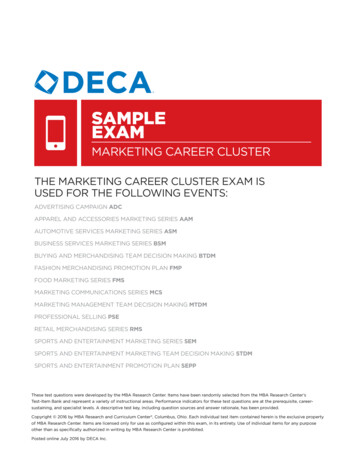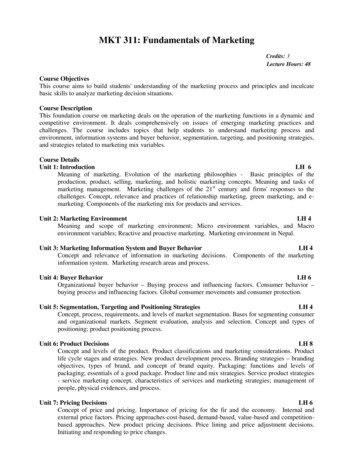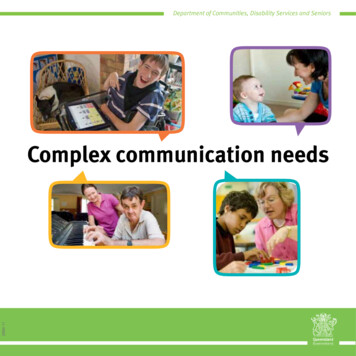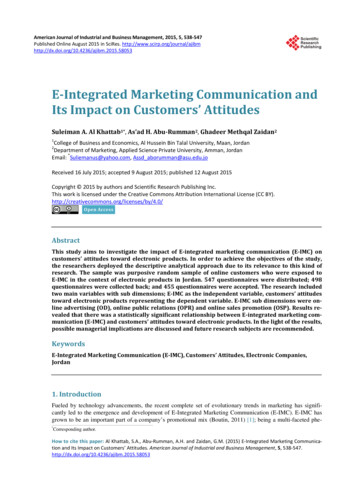
Transcription
American Journal of Industrial and Business Management, 2015, 5, 538-547Published Online August 2015 in SciRes. g/10.4236/ajibm.2015.58053E-Integrated Marketing Communication andIts Impact on Customers’ AttitudesSuleiman A. Al Khattab1*, As’ad H. Abu-Rumman2, Ghadeer Methqal Zaidan21College of Business and Economics, Al Hussein Bin Talal University, Maan, JordanDepartment of Marketing, Applied Science Private University, Amman, Jordan*Email: Suliemanus@yahoo.com, Assd aborumman@asu.edu.jo2Received 16 July 2015; accepted 9 August 2015; published 12 August 2015Copyright 2015 by authors and Scientific Research Publishing Inc.This work is licensed under the Creative Commons Attribution International License (CC tractThis study aims to investigate the impact of E-integrated marketing communication (E-IMC) oncustomers’ attitudes toward electronic products. In order to achieve the objectives of the study,the researchers deployed the descriptive analytical approach due to its relevance to this kind ofresearch. The sample was purposive random sample of online customers who were exposed toE-IMC in the context of electronic products in Jordan. 547 questionnaires were distributed; 498questionnaires were collected back; and 455 questionnaires were accepted. The research includedtwo main variables with sub dimensions; E-IMC as the independent variable, customers’ attitudestoward electronic products representing the dependent variable. E-IMC sub dimensions were online advertising (OD), online public relations (OPR) and online sales promotion (OSP). Results revealed that there was a statistically significant relationship between E-integrated marketing communication (E-IMC) and customers’ attitudes toward electronic products. In the light of the results,possible managerial implications are discussed and future research subjects are recommended.KeywordsE-Integrated Marketing Communication (E-IMC), Customers’ Attitudes, Electronic Companies,Jordan1. IntroductionFueled by technology advancements, the recent complete set of evolutionary trends in marketing has significantly led to the emergence and development of E-Integrated Marketing Communication (E-IMC). E-IMC hasgrown to be an important part of a company’s promotional mix (Boutin, 2011) [1]; being a multi-faceted phe*Corresponding author.How to cite this paper: Al Khattab, S.A., Abu-Rumman, A.H. and Zaidan, G.M. (2015) E-Integrated Marketing Communication and Its Impact on Customers’ Attitudes. American Journal of Industrial and Business Management, 5, 538-547.http://dx.doi.org/10.4236/ajibm.2015.58053
S. A. Al Khattab et al.nomenon that entitles a mix and synergies of all internet-based communications and is considered to be an expansion in itself of modes of distribution. E-IMC has multiplicity of well-recognized capacities and benefitssuch as low-cost, speed (instantaneous communication), geographic barrier reduction and efficiency (Thurau etal., 2010) [2]; (Kumar, 2012) [3]. This all strategically led organizations to positively adopt E-IMC characterized by a proactive-reactive attitude, consistency, continuity, flexibility and customization (Valos et al., 2010)[4].This rapid pace of change in marketing communications has profoundly influenced customers’ behavior as awhole and specifically customers’ attitudes toward products in this evolving interactive market space (Ozuem etal., 2007) [5]. In summary, this research concerned itself with the impact of using E-IMC on customers’ attitudes toward electronic products in Jordan, shedding light on online trust as a moderate variable. Understandingcustomers’ responses to such emerging digital multi-communication multi-channel and multi-category environment helps firms in formulating better behavioral targeting strategies; that is to reach out customers based onwhere they are located and what their interests are. This dynamic research helps to understand how emergingmedia can augment traditional media. This is extremely critical for better management of customer relationshipsand development of strategies that aim at an effective allocation of budgeted promotional dollars through its dynamic impact on customers’ attitudes, purchase incidence and quantity decisions.Integrated Marketing Communication (IMC) has received almost instant recognition by the mid of the 1990s(Porcu et al., 2012) [6]. The factors that mainly interplayed leading to such escalating recognition were cost reduction apart from mass traditional advertising into a more personalized communication (Tetteh, 2015) [7].Further reasons are fragmentation of media, customers and internet in addition to mobile technologies giving theadvantage of a more centralized management as well as corporate message consistency (Winer, 2009) [8]. Allprevious factors leveraged this mode of communication not only to cultivate a deeper bond with customers andinfluencers but also to maximize return on investment (ROI) by integrating traditional marketing communications with E-IMC side by side (Kumar, 2012) [3]; (Morozan and Ciacu, 2012) [9].The rapid development of internet, its acceptance and usage rate has been noted widely in the last ten years(Lovett, 2010) [10] reshaping and changing marketing communications leading to the creation of E-IMC as amajor constituent discipline of IMC. The internet characteristics, interactivity, transparency and memory, havetransformed the profile and behavior of online audiences into gaining more control than ever and a more proactive attitude (Gurau, 2008) [11]. The online audience is now more connected to the organization in an interactivetwo-way communication process (Valos et al., 2010) [4]. Not only that, but also more connected to each other,just a click away shedding the light on the role of electronic word of mouth in creating a positive or negative influence (Owen and Humphrey, 2009) [12]. It is absolutely true that audience has more access to information andthey can easily pull information that suits their interest and needs.Traditional IMC is theoretically pragmatic; what is meant is that on real grounds it does not fit easily into theorganizational structure adopted by most firms (Percy, 1997) [13]. Of the most significant structural barriers totraditional IMC implementation are lack of budget and lack of database technology, escalating increase of markets’ and media audiences’ fragmentation, saturation of traditional media channels, new recurring marketingconcepts like focal relationship marketing, in addition to internet users’ acquisition of more control and powerover the communication process due to prevalence of internet and recent advances in information technology(Fang et al., 2014) [14].Because of these important realities for most companies in such a highly-competitive environment, there is anecessity to implement effectively and efficiently the concept of E-IMC integrated as part of IMC. It is considered as one of the best ways to encounter such difficulties. Internet is noticeably growing in use in Jordan; it isestimated by Telecommunication Regulatory Commission that internet users in Jordan are 5.7 million users(ALARABALYAWM, 2015) [15]. Jordan is ranked second in Internet usage in the Arab world (47 per cent),Around 84 per cent of Internet users in Jordan use the service every day, and also third in engagement in socialnetworking sites among Arab states (JORDANTIMES, 2014) [16]. Nevertheless, E-IMC applications still facechallenges in its application in the Arab World and specifically Jordan due to cultural constraints, customers’lack of knowledge competence in using the internet, lack of online trust, and lack of financial abilities to keeppace with technology advancements (electronic imports of Jordan declined 33.5% in the first five months of2014 (273.2 million JD) in sharp comparison with 2013 (410.9 million JD) (DOS.GOV, 2014) [17]. Other reasons are businesses’ lack of horizontal communication, functional specialization, decentralization, lack of IMCplanning and expertise, corporate culture and fear of change (Percy, 1997) [13]; (Al-Shoubaki, 2008) [18].539
S. A. Al Khattab et al.In this context, this study has investigated the impact of E-IMC on customers’ attitudes toward electronicproducts specifically, whether positive or negative, that might eventually lead to purchase intentions and behavior.2. Literature ReviewSince the 1990s, integrated marketing communication (IMC) has gained prevalent significance as a strategicmarketing management approach (Zavrsnik and Jerman, 2011) [19] due to the effectiveness of the integration ofmarketing communications tools (i.e. advertising, public relations, direct marketing, sales promotion and personal selling). This integration optimizes the communication impact on targeted customers (Vantamay, 2011)[20]. IMC adopts a holistic view of marketing communications with the objective of synergy of effects (Sericand Rijeci, 2012) [21]. IMC framework relies upon the deployment of multiple communication channels; inclusive of both traditional communications and E-integrated marketing communication (E-IMC), to enhance thecontribution of each of them. It is rather a relational process and business competency at the same time. Its objective is to develop and maintain strong beneficial relationships with all stakeholders through ongoing two-waydynamic dialogue and communications. This will have its definite positive impact on sales and profits (Zavrsnikand Jerman, 2011) [19]. In other words, it is a move with main prints from traditional media to two way channels of communication (Tetteh, 2015) [7]. As for the term business competency; the capabilities of integratedmanagement for various media channels help to reach superior results and synergistic outcomes (Chun et al.,2014) [22].2.1. E-Integrated Marketing Communication (E-IMC)E-IMC is a relatively new communication discipline that was declared to be a separate line of communicationdisciplines. Jensen and Jepsen (2006) [23] offered a new typology for E-IMC. A four-discipline model proposedincluding fifteen sub tools that were inferred from main works researchers studied. These four disciplines ofE-IMC are online advertising, online public relations (PR), online sales promotions and online relationship communications. Integration and exploitation of all previous tools are essential to create value to grasp full E-IMCpotential resulting in more holistic marketing communications. The study advised that E-IMC disciplines shouldbe integrated with those of traditional IMC by finding the right mix, since E-IMC potential is very large if usedin a targeted way. E-IMC characteristics by far surpass any offline media channel (Hoffman and Novak, 1996)[24]. E-IMC allows for all types of communication; to transmit information to customers, to provide consultation, to register click through as well as interact online. The researchers have treated E-IMC tools as one discipline due to their shared characteristics. These characteristics are freedom from temporal and spatial restrictionswhich means customers’ accessibility to information without any geographical or temporal limitations. Moreover, E-IMC is about many-to-many communication, interactivity, hypertextuality, and personalization. Thus, allthat definitely results in efficiency at a sustainable low cost. Jensen (2007) [25] suggested five-discipline modelthat included thirteen communication tools deduced. According to the researchers, E-IMC disciplines are onlineadvertising, online relationship marketing, online interactive communication, online public relations (PR) andmobile communications. While Winer (2009) [8] acknowledged that media landscape has dramatically been affected in the early part of the 21st century due to emergence of new technologies. The author aimed to provide anoverview of this new media employed and stated some major measurement issues, problems, challenges and future research opportunities posed. Internet advertising had augmented all other established marketing tools usedfor the last fifty-one hundred years. Although traditional media is not disappearing, major marketers are shiftingtheir spending into the new media categories. The new media is about interactivity, internet and digital media.Marketers are taking advantage of these new media channels to create targeted campaigns that can reach specificsegments and engage customers to a much greater extent than traditional media (Ho et al., 2014) [26].Alexandru and Carmen (2011) [27] investigated the main role online communication plays in relationshipmarketing. This was done among managers of Romanian tourism companies with the purpose of identifying themain online communication tools used to attract, keep and develop customers’ long-term relationships in onlineenvironments. The researchers figured that although the notoriety of online marketing tools is high, some ofthese tools, known only by definition, are not used in practice and vice versa. They mentioned that online toolswere classified depending on the purpose whether to attract or maintain customers. The study concluded that themost efficient online tools to attract customers are company’s websites, search engines, sponsored links,540
S. A. Al Khattab et al.e-newsletters, email marketing, social networks and online advertising. Whereas the most efficient online toolsto maintain customers relationships are websites, e-newsletters, email marketing, social networks and instantmessaging.Morozan and Ciacu (2012) [9] have emphasized, that marketing communication is globalizing on the internet.This rapid adoption of new advanced technologies transformed production, distribution and consumptionprocesses. The optimization of online channels must be deeply rooted and based on key performance indicators.Success is not guaranteed on the internet, it requires originality of products and ideas.Rakic and Rakic (2014) [28] analyzed IMC integration through five aspects; media, communication methods,line of communication and possibilities of interaction, actors in addition to content creation. They emphasizedthat digital environment changed IMC. There is a shift towards digitization of communications and entire businesses. This kind of digitization is becoming a necessity for survival in the competitive environment. Not onlythere is digitization in communication, but also in customers and environment. Customization as a strategy offers additional competitive options in the overall marketing strategy and digitized world.Online advertising: Jensen (2007) [25] classified online advertising into three primary sub tools. First, displayadvertising such as banners, pop-ups, and interstitials. Second, is search engine Optimization (SEO) or searchengine marketing (SEM). SEO can be divided into organic and paid optimization. On one hand, SEO can givepermanent high rankings and traffic, whereas SEA is a rather short term yet considered fast way to generate traffic. Third, are affiliate programs, are usually paid to the host on the basis of the number of leads converted intocustomers, pay-per-conversion, or by the number of leads referred.Mohammed and AlKubise (2012) [29] also emphasize the importance of positive customers’ attitudes towardwebsites in relation to the effectiveness of online advertising as well as trust in online contexts. Online trust iscrucial as per study because of its effects on customers’ purchasing intentions.Online public relations (PR): PR is considered as always a tool to serve an as electronic brochure full of information needed. It is attractive due to its value, ability to acquire and overload information, short time spanand availability all the time everywhere. Moreover, there are SEO and community building apparent in chattingrooms and discussion groups (Boutin, 2011) [1]. Huang et al. (2012) [30], categorized online PR into virtualpress centre (VPC) which is easy to use as said by Haig and viral marketing. Viral marketing is a deliberatespreading of a message through online word-of-mouth. It can be carried in emails, streaming videos and audios,games, programs, websites, pictures or simple documents. Deodhar, (2014) [31] emphasized the tremendouspotential of social networking sites (SNS’s) as a marketing medium because of their interactivity, accessibilityand efficiency. The author stressed that when used effectively, social media does strengthen relationships withcore customers and increase profits.Online sales promotion is the third major tool of E-IMC. Online sales promotion takes different forms such aselectronic coupons, electronic samples, contest and sweepstakes. Al Shoubaki (2008) [18] stated that the goal isto increase traffic and build customer database On the other hand, Jensen (2007) [25] has classified what hecalled online interactive communications to include online coupons, online samples, contests and sweepstakes,microsites and games. These online sales promotion tools are usually used to encourage trial, involvement andrepeated purchase, thus to increase sales.2.2. Customer AttitudeThere are so many studies that tackled customer attitude being a subject of high significance to marketers.Al-Alak and Al-Saed (2006) [32] investigated the impact of customers’ attitudes toward website and whetherthese attitudes affect subsequent attitudes toward the brand and internet advertising. The researchers found thatthere is a definite positive impact on customers’ attitudes toward brands seen on the internet through more brandrecall and favorable views of the brand. According to the authors, customers need to be consulted about certainfeatures of the website, and marketers must pre-test it before launch to increase its effectiveness. Jahangir andBegum (2007) [33] suggested a conceptual framework to study the impact of perceived usefulness, ease of use,security and privacy on Customer Attitude. They found out these variables are antecedents of customer attitudeand they positively foster customer adaptation. Therefore, firms need to work on the development of positivebeliefs on the customer’s end. The authors also confirmed that customer attitude has a strong positive impact oncustomer’s intention to behave being a mediator for customer adaptation.Madhavaram and Appan (2010) [34] in their study found that the mainly focused on nonintrusive web-based541
S. A. Al Khattab et al.marketing communications influenced more customers’ explicit brand attitudes than implicit attitudes and viceversa. Second, organizations that focused primarily on intrusive web-based marketing communications had apositive effect on customers’ impulse purchases through customers’ implicit brand attitudes. Third, althoughcustomers’ explicit attitudes toward intrusive web-based marketing communications were negative, consumerswill hold positive implicit attitudes toward a well-known brand in sharp comparison with an unknown brand fora specific product. Huang et al. (2012) [30] confirmed that eWOM communications have a definite impact oncustomers’ product attitudes and behavioral intentions. Customers rely on relationships with online communitiesto assess information quality. According to the above literature, the research model and the hypotheses havebeen prepared (Figure 1).2.3. The Main HypothesisHo.1: There is no significant impact of electronic integrated marketing communication (E-IMC) on customers’attitudes.Sub HypothesesHo.1.1: There is no significant impact of online advertising on customers’ attitudes toward electronic products.Ho.1.2: There is no significant impact of online public relations on customers’ attitudes toward electronicproducts.Ho.1.3: There is no significant impact of online sales promotion on customers’ attitudes toward electronicproducts.3. Research MethodologyThe methodology used in this study is descriptive and analytical. The goal is to develop an appropriate methodin order to achieve the objectives of this study which included a series of questions analyzed statistically to testthe hypotheses of the research and made good use of many different literature references and sources to build atheoretical and practical background and research based on previous and new studies. Nominal, ordinal and Likert five scales are used to answer research questions and verify results achieved.3.1. Population and Sample of the ResearchThe population of the study consists of all customers whom are exposed to IMC in the context of electronicproducts from all electronic companies in Jordan.3.2. Sample and Unit AnalysisThe sample consists of online customers whom are exposed to E-IMC in Jordan. The researchers distributedIndependeant variableE-IntegratedMarketingOnline advertisingOnline publicrelationsOnline salespromotionDependant variableCustomer' Attitude Toward ElectronicProductsFigure 1. Research model.542
S. A. Al Khattab et al.paper and online questionnaires to get sample responses. As for The unit sample (unit analysis); online customers whom are exposed to E-IMC in Jordan in the context of electronic products from all electronic companies,the sample that is used in this study is called purposive random sample and the criterion used to select unit sample (unit analysis) is to exposure E-IMC channels. The distributed number of responses was 547 questionnaires,455 questionnaires were accepted. This sample was distributed in both online and traditional offline surveysummarized in the Table 1 below.In order to achieve the study objectives, a questionnaire was developed. Nominal, ordinal and Likert fivescale were applied in the questionnaire and measurement of the study variables which was organized rangingfrom “1 strongly disagree” to “5 strongly agree”. The questionnaire was developed to collect data from thesample of the study after reviewing some of the previous literature addressing each of the variables examined inthe study, it contains three main questions, the first group is about demographic question, such as (age, gender,nationality, marital status, level of education, and work sector) about the study population, the second is aboutE-IMC which includes three sub domains and was covered by (15 questions): Online Advertising (5 questions),online public relations (5 questions), online sales promotion (5 questions). The third group is about customers’attitudes toward electronic products (5 questions).3.3. Reliability of the StudyTo declare the sincerity of the survey variables for the phenomenon being studied, study reliability was calculated that indicated the extent of reliance of measurement tool in giving the same results. This was done by usingtest pre-test method, in which the researchers applied the study tool on a sample of 60 customers of the sample,after three weeks the same or similar sample was tested again; the consistency degree was 90%. To test thestudy reliability, Cronbach’s alpha technique was used for this purpose, and its value for all of the domains was(94.9%) as shown in Table 2.3.4. Descriptive Statics and Sampling CharacteristicsThe descriptive statics includes the descriptive results of the sample, the unit of analysis, and the study variablesstatements. The sample was described by personal and functional factors based on online respondent’s characteristics that are exposed to E-IMC in Jordan in the context of electronic products as shown in Table 3.3.5. Description of Study VariablesDescriptive statistics, the researchers computed the means and standard deviations for all the study domains asshown in Table 4.Table 1. Description of the questionnaire responses.Frequency percentageNo. of accepted questionnairesNo. of distributed questionnairesDistribution method47.47216291Online method52.53239256Offline (traditional) method100.0455547TotalTable 2. Reliability test using Cronbach alpha.Cronbach alphaNo. of itemsVariables0.90320E-Integrated Marketing Communication (E-IMC)0.8265Online advertising0.7165Online public relations0.7745Online sales promotion0.9245Customers’ attitudes toward electronic products0.94938All variables543
S. A. Al Khattab et al.Table 3. The frequencies and percentages on personal levels of the respondents.PercentFrequencyPersonal factors59.6271Male40.4184Female0.94Less than 1839.117818 - less than 2843.119628 - less than 3811.65338 - less than 484.42048 - less than 580.9458 years and above95.2433Jordanian4.822Non 7High school or less10.347Diploma64.2292Bachelor21.899Higher studies10.347Public sector75.4343Private sector14.365Not workingGenderAge (years)NationalityMarital statusEducationWork sectorFrom the previous Table 4 the mean range for all domains is from (3.4264) to (3.8985) referring to a degreeof agreement, in which online public relations got the highest mean (3.8985) and standard deviation (0.70989),and the domain customer attitude with the lowest mean (3.4264) and standard deviation (0.86733).4. Testing the Study Hypotheses4.1. The Main HypothesisHo.1: There is no significant impact of E-integrated marketing communication (E-IMC) on customers’ attitudestoward electronic products.Simple regression was performed and the results in Table 5 showed that the strength of the relation betweenthe overall dimensions of E-integrated marketing communication (E-IMC) and customers’ attitudes toward electronic products was (R 72.3%), and the coefficient of determination (R2 0.522) which is an acceptable percentage, meaning that (52.2%) of the total differences in the customers’ attitudes toward electronic products isdetermined by E-integrated marketing communication (E-IMC), and the remaining percentage equal to (47.8%)represents the contribution percentage of the excluded variables that were not included in the study model. Thevalue of computed (F 494.842) which is higher than the tabular F at degree of freedom (1-454) at significancelevel of (0.000). This indicates that the curve of regression is good in explaining the relation between E-integrated marketing communication (E-IMC) and customers’ attitudes toward electronic products.The results of simple regression analysis showed that there is a significant impact of the E-IMC on customers’attitudes toward electronic products, (β 0.723) at level of significance (0.000).544
S. A. Al Khattab et al.4.2. Sub-HypothesesThe results of the analysis (Table 6) showed that there is a significant impact of online advertising on customers’attitudes toward electronic products, (β 0.251) at level of significance (0.000). The results of the analysisshowed that there is significant impact of online public relations on customers’ attitudes toward electronicproducts, (β 0.128) at level of significance (0.003). Also, the results of analysis showed that there is significantimpact of online sales promotion on customers’ attitudes toward electronic products, (β 0.227) at level of significance (0.000).5. Findings and DiscussionThis study investigated the influential impact and relationship between E-Integrated Marketing Communication(E-IMC) and its channels in the electronics markets in Jordan with customers’ attitudes toward electronic products. Based on the assumption o main hypothesis in addition to their sub hypotheses set the results of the research and rejects each hypothesis as per the answers of the questionnaire. Thus, the alternative hypotheses arecorrect and acceptable, which means that E-Integrated Marketing Communication (E-IMC) and its channels influence directly customers’ attitudes toward electronic products.The results showed that the most efficient and applicable channels of E-Integrated Marketing Communication(E-IMC) in the electronics markets in Jordan. The studied E-IMC channels were (Online advertising, onlinepublic relations and online sales promotion). This research concluded that each of the studied channels ofE-IMC affect customers’ attitudes toward electronic products having certain degrees of differences as shown inchapter four.The results of the analysis showed that there is significant impact of E-IMC on customers’ attitudes towardelectronic products where (β 0.723) at level of significance (0.006). This result is attributed to the acknowledged reality that E-IMC in all its channels, if utilized effectively, can be a competitive edge on its own. Customization, personalization, targetability, accessibility, economic expansion with high reach, interactivity, engagement, cost-reduction, improvement of corporate image, significant increase on sales, and facilitation ofTable 4. Means and standard deviations for the study main domains.Agreement degreeStd. deviationMeanItemMedium0.579473.6427E-Integrated Marketing Communication (E-IMC)Medium0.707773.5785Online advertisingHigh0.709893.8985Online public relationsHigh0.626283.6985Online sales promotionMedium0.867333.4264Customers’ attitude toward electronic productsTable 5. The impact of overall E-IMC on customers’ attitudes toward electronic products.SigTΒIndependent variable0.000*22.2450.723E-IMC(R 0.723; R2 0.522; F 494.842); *Significant level at P 0.05.Table 6. The impact of E-IMC (dimensions) on customers’ attitudes toward electronic products.SigTΒIndependent variable0.000*5.7730.251Online advertising0.006*5.2020.227Online sales promotion*3.0210.128Online public relations0.003(R 0.726; R 0.528; F 125.631); Significant level at P 0.05.2*545
S. A. Al Khattab et al.communication process are of the many advantages of E-IMC exemplified in the synergy of all its channels. It israther becoming a necessity these days. By analyzing the results of E-IMC channels, it shows that there is a significant impact of online advertising on customers’ attitudes toward electronic products where (β 0.251) atlevel of significance (0.000). In addition, the analysis of online public relations (OPR) shows the significant impact of OPR on customers’ at
[20]. IMC adopts a holistic view of marketing communications with the objective of synergy of effects (Seric and Rijeci, 2012) [21]. IMC framework relies upon the deployment of multiple communication channels; inclu-sive of both traditional communications and E-integrated marketing communication (E-IMC), to enhance the contribution of each of them.
